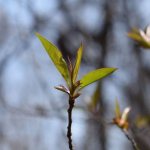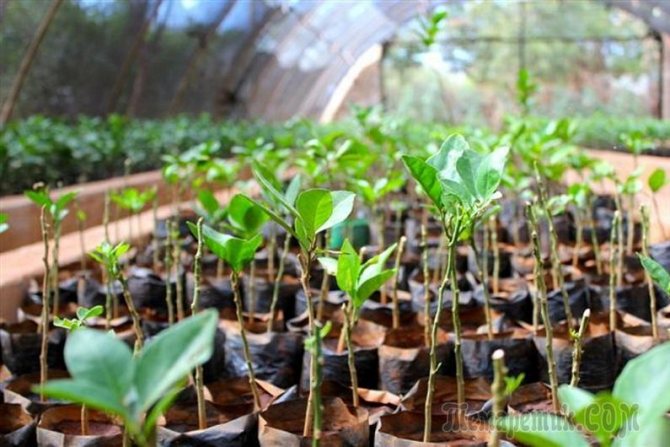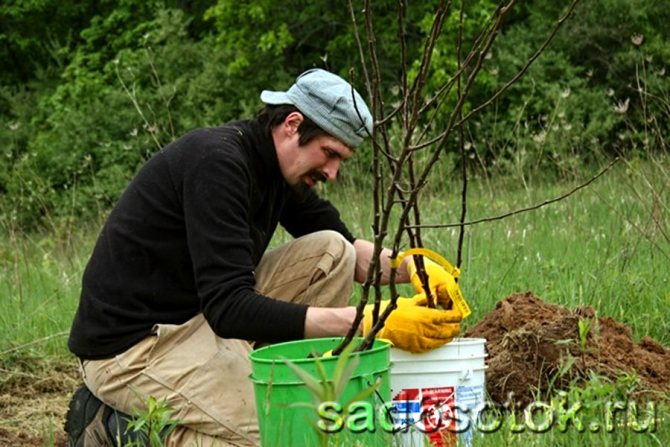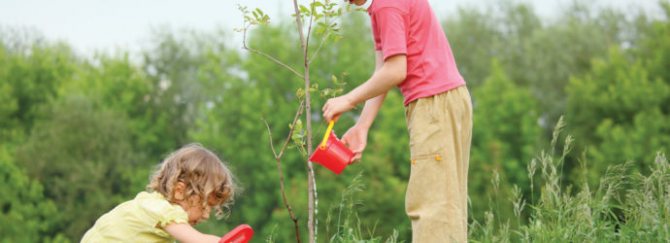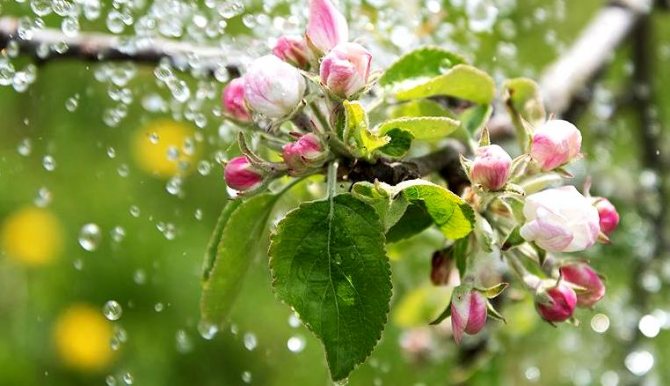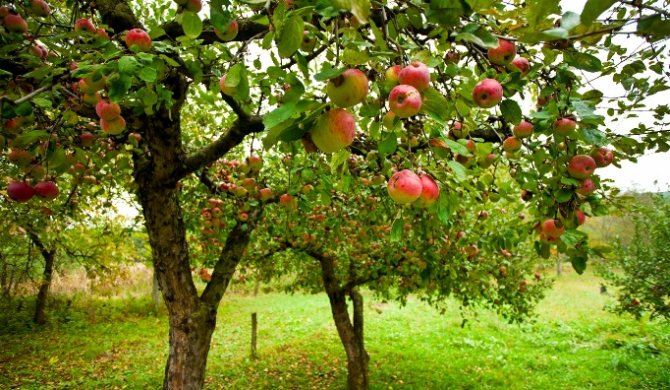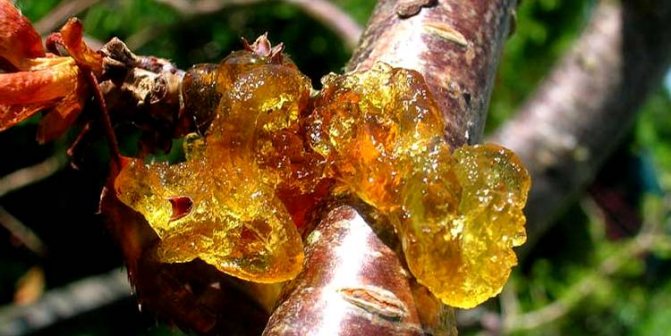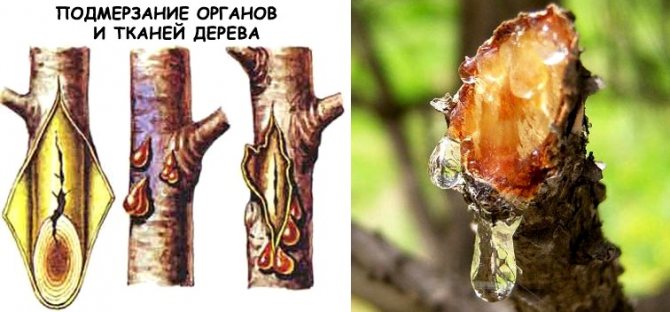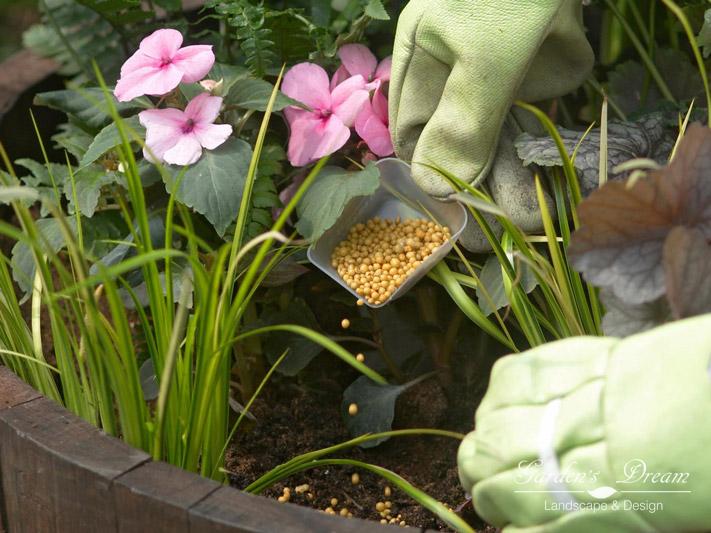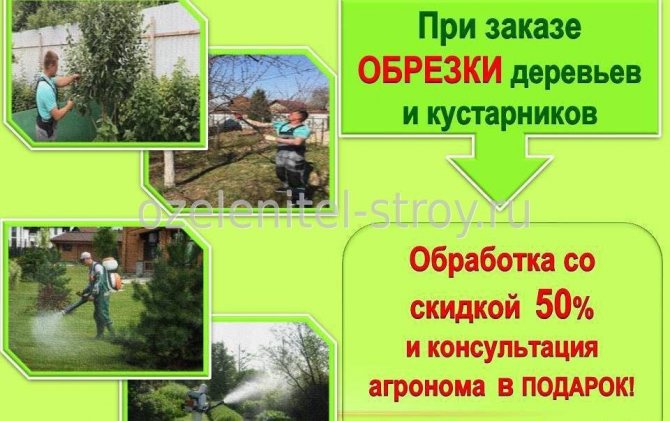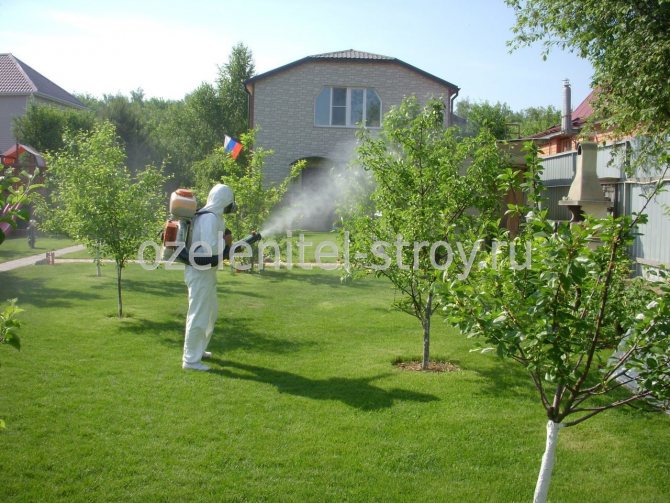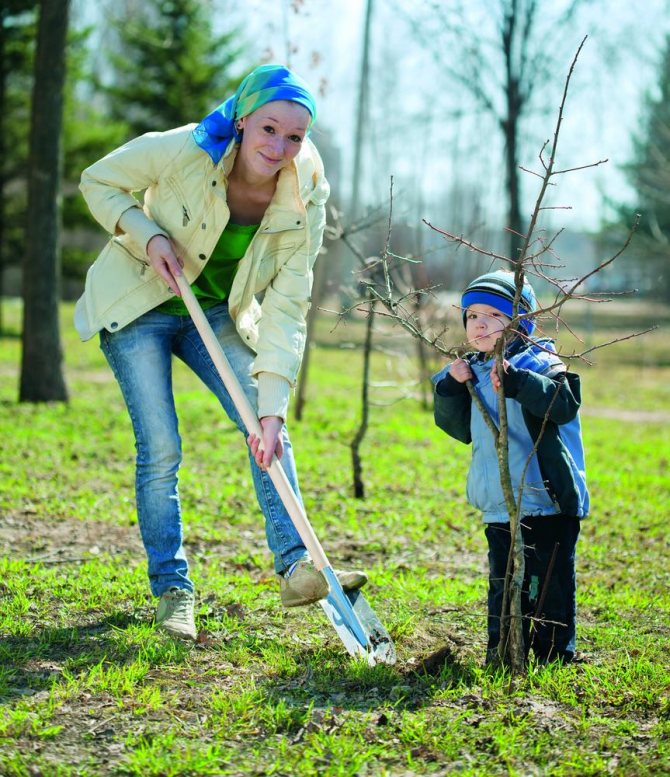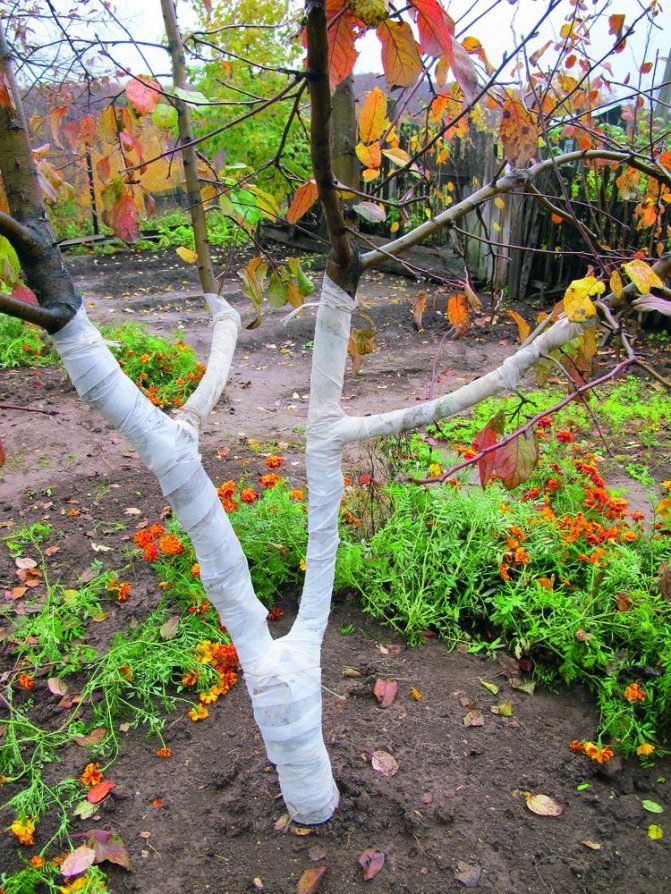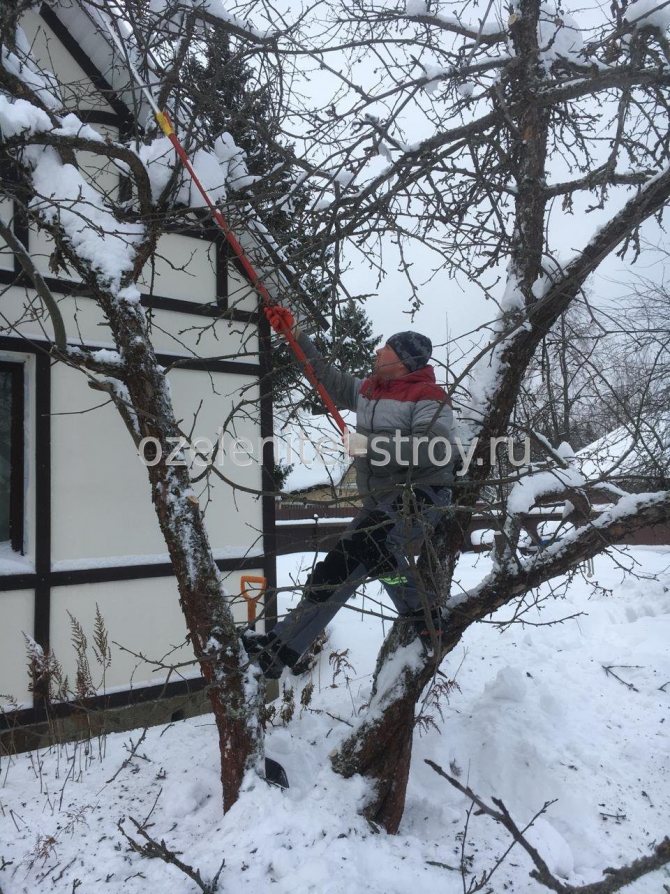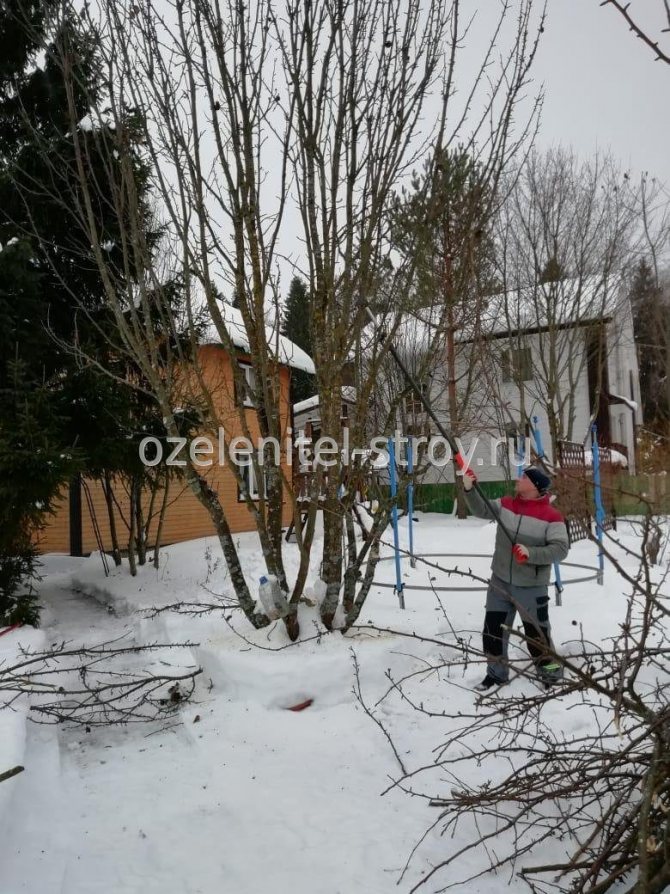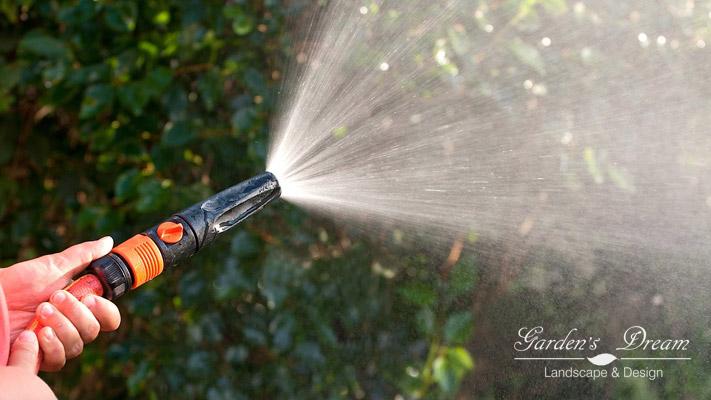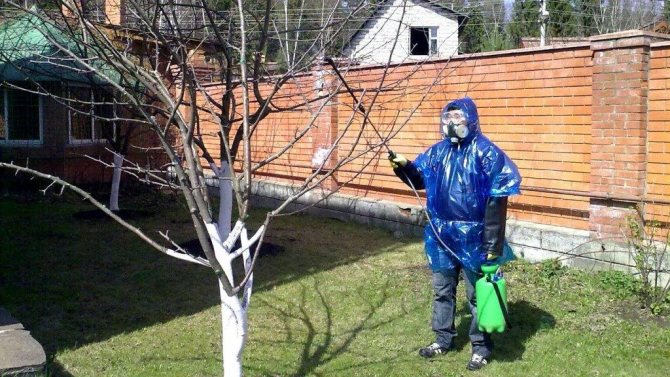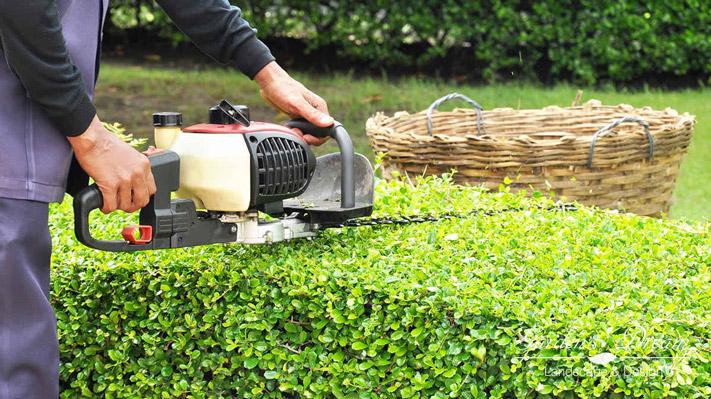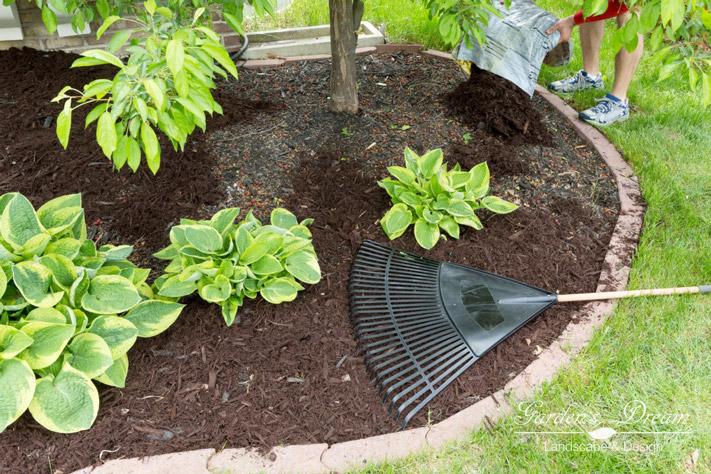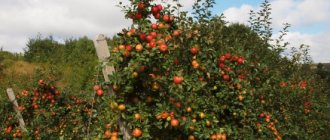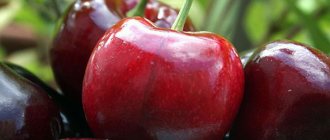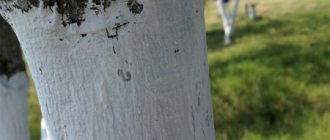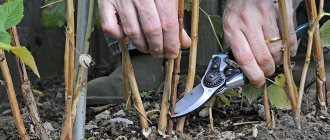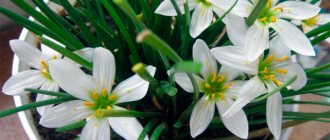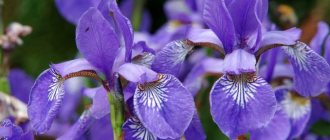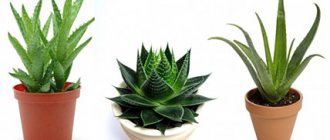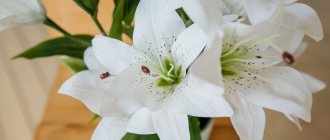How to make your seedlings turn into strong fruit trees and live happily ever after - don't forget the little things!
To begin with, transplanting a tree is itself a painful procedure for a plant that urgently needs to regenerate its root system in a new place.
Therefore, pruning the seedling after planting should be minimal and limited to only broken branches or branches with dead wood. Set aside shaping pruning for up to one or two seasons until the tree is strong.
How to install a support under a seedling correctly
Contrary to the popular belief that the seedling should be firmly tied to a support, some gardeners believe that most newly planted trees do not need this, except when the tree is planted in the fall and in an open, windy place. Even then, the support should be removed in the spring immediately after the onset of favorable weather. Why? The tree's dependence on support would supposedly prevent it from developing sufficient trunk strength.
But the adherents of traditional gardening are sure that supporting the seedling is necessary, since the root system suffered damage during transplantation, which limited the plant's ability to extract water and nutrients from the soil. Once the tree is planted, it will exert all its strength to stand upright. A gardener can help him by following the correct steps:
Install at least two, or even better three, stanchions at equal distances from the trunk.
The distance between the trunk and the supports should be at least 60-70 centimeters to avoid injury to the root system.
Anchor the supports firmly in the soil with a 60 centimeter depression.
Tie the tree to the stakes with a suitable biodegradable material such as burlap. Avoid using wires and rubber hoses to avoid wounding the thin bark of the young tree.
The tension on the material should not be too strong. Make the tree sway slightly in the wind.
Protect the seedling with a plastic shield from a possible attack by hares or deer, spray the tree with Freitenmouth repellent, VE from mouse-like rodents, or make scaring bookmarks. Remember that excessive wrapping of the seedling for the winter with numerous layers of burlap or paper will create an environment for the accumulation of insects, including harmful ones, and will not benefit the plant.
How to avoid sunburn
Sunburn is especially dangerous for the bark of young trees. In early spring, the sun's rays, reflecting from the snow-white surface, strongly heat the bark on the southern side of the trunk during the day, while at night it freezes. Such sudden temperature changes lead to rupture of the crust and even to its death.
Tying boles helps in such a situation, at the same time this measure serves as protection from rodents. In spring, the harness is removed, preferably on cloudy days - in sunny weather, the delicate bark can get burned. By performing these simple steps, you can be sure that the seedlings will overwinter well and will actively develop.
How to water a seedling when planting in the fall
Proper watering methods are vital for your seedling to stimulate root growth and provide moisture to the entire plant.
Watering methods should be appropriate for the tree species, environment, soil type, and drainage.
Young plants require more moisture than similar mature trees with a well-developed root system. The soil type will also affect the watering schedule. Clay soils are watered less frequently, but more abundantly than sandy ones.
Each new tree should be well watered immediately upon planting to a depth of 40 centimeters to eliminate air pockets and ensure density. Thereafter, it is also watered abundantly twice a week for the first few weeks, until the root system is established.
Be careful not to overfill the seedling! Watering too often will cause the leaves to turn yellow and fall off.
Therefore, check the soil for dryness before watering. If the top 5-10 centimeters are completely dry, it's time to water the seedling. A slow trickle of water from a garden hose left in the root zone for several hours is more beneficial than short, frequent watering, which encourages the root system to grow closer to the surface and makes the tree more vulnerable to environmental stress.
Continue watering until mid-fall, reducing irrigation frequency as temperatures drop. Before the onset of the final frost, carry out moisture-charging irrigation - not only for seedlings, but also for all other fruit trees.
How to fertilize seedlings
Trees growing in the wild do not receive any additional fertilization and nevertheless continue to grow and develop. In this they are helped by organic matter, which is obtained from the decomposition of fallen leaves and animal droppings.
Garden trees, on the other hand, often grow in soil where there are not enough nutrients for satisfactory growth, such as nitrogen, phosphorus and potassium. Often in the fall, gardeners remove leaves and other plant debris from the surface of the earth, preventing them from rotting, so to speak, at the root of trees.
In the case of seedlings, young plants must be provided with nitrogen, phosphorus and potassium. The best time to apply phosphorus and potash fertilizers is before planting the seedling during the preparation of the pit: mix in equal parts a handful of fertilizers, add the top layer of earth, mix everything again and put on the bottom of the hole.
A complete fertilizer containing nitrogen, phosphorus and potassium is also commercially available. Remember that synthetic fertilizers are always released quickly when dissolved in water, while organic fertilizers dissolve more slowly.
When fertilizing seedlings, use sustained-release or controlled-release fertilizers. For example, to determine if a nitrogen fertilizer is a fertilizer, look at the percentage of water insoluble nitrogen on the label. If about half of the nitrogen is water insoluble, it is considered a slow release fertilizer.
After fertilization, the soil must be watered without fail, which, in principle, is what any gardener does.
The advantages of synthetic fertilizers include the relatively quick elimination of nutrient deficiencies in the soil. Such a tree grows vigorously, is less susceptible to disease and bears fruit well.
The disadvantages of synthetic fertilizers include the fact that sometimes gardeners pour them too generously and get the opposite effect. So, an excess of nitrogen fertilizers promotes the growth of green leaves and can delay flowering, and when high vines of soil fertilizers are applied in July and August, the growing season will shift, the young tree will not go dormant in winter and may die. Therefore, in the second half of summer, it is better to use liquid foliar fertilizers Folirus for feeding young trees. They are recommended for organic farming, improve the sugar content of the fruit and can be used before harvest.
First work in the garden
Work in the garden begins with the release of the branches of the plantations from melted snow, if at the end of winter there was an abundance of precipitation.From the spring sun, the snow becomes loose and heavy, it can easily break thin branches. To avoid this, shake it off. If the branches have already buckled and fell, build supports to support them.
The next tip is relevant for areas with a slope. So that the melt water is retained and the flood does not erode the soil, build snow ramparts across the slope.
Stock up on melt water - it is rich in useful microelements. For this, containers must be filled with snow and added as it melts.
With the arrival of spring, not only vegetation wakes up - rodents and pests are ready to activate. Inspect existing bait poisons, prepare new ones if necessary.
The snow has melted - start cleaning the garden. Collect old leaves and other debris, and get rid of weeds if they appear.
What mulch to choose for a seedling
Natural trees create their own mulch by dropping their leaves, twigs, fruits and flowers into the root zone. A thick layer of litter protects the tree from cold weather and nourishes the roots with useful elements.
In the garden, you can simulate this process by using mulch with organic wood chips around the trees.
- Reduces weed problems
- Reduces soil compaction and erosion
- Retains moisture
- Monitors soil temperature
- Improves aeration and soil structure
- Just looks good
On average, a layer of mulch for a seedling is recommended with a thickness of 5 to 10 cm. However, to avoid wet conditions near the bark and to prevent tissue decay, make sure that the mulch does not touch the tree trunk.
How to care for trees: mulching the soil and eliminating hollows
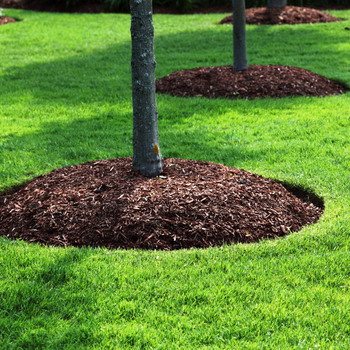
How else to care for trees in the garden to ensure their active growth? It is necessary to carry out activities such as mulching the soil and eliminating hollows.
After planting young plants, their trunks are mulched. The soil under the mulch does not form a crust, does not crack and retains moisture for longer. Mulch with any loose, harmless material: sawdust, peat, moss, last year's leaves, branches, etc. Some people prefer dark plastic wrap. A coating layer is recommended for moss and peat about 4 cm, for looser materials up to 12 cm.However, you should not mulch in damp cold weather, the roots may get wet.
The remains of skeletal branches after breaking off their parts, as well as hollows, can be a site for the development of infection. These damage must be cleaned with a sharp knife, disinfected with a 5% solution of iron or copper sulfate. Then they are closed up. In the process of caring for garden trees, do not forget to cover the cuts of branches with garden varnish or oil paint. The hollow is filled with cement with sand, crushed stone, brick chips or molten asphalt with sawdust. A positive effect in wound healing is provided by the addition of a heteroauxin growth stimulator at a concentration of 0.01–0.025%.
Fruit trees
Per seedlings of fruit trees, care is especially important in the first two years after planting... At first, the tree only takes root, and in the second year its normal growth begins. This is the period of the formation of the "character" of the tree and its health - its future is being shaped.
If during planting a sufficient amount of organic and mineral fertilizers was applied, there is no need to feed the seedlings in the first two years.
RARE PLANT SEEDS FOR YOUR GARDEN - FREE SHIPPING. PRICES ARE VERY LOW. THERE ARE REVIEWS


If fertilizers were not added to the pit, then 2-3 weeks after planting, the plants need to be fed with mullein or chicken droppings, as well as a solution of mineral fertilizers, especially nitrogen fertilizers. Subsequently, top dressing should be carried out according to agricultural technology.
Wet soil is important for a young seedling. Depending on the weather conditions, the plants are watered periodically, abundantly.You can use a drug that stimulates root growth with water.
However, you need to know when to stop: you cannot water the plantings daily, this leads to waterlogging of the soil and often to the death of trees. Roots not only consume water, they need oxygen for normal life. Excessive moisture displaces air from the soil, which leads to root rot.
After watering, it is advisable to mulch the soil around the seedling with peat, sawdust (cover with a layer of 5-8 cm) or black non-woven material. Mulch inhibits moisture evaporation and reduces the amount of watering.
If the planting was carried out this spring, the buds on the seedlings can wake up until mid-June - this begins the development of the aboveground part of the seedling. The kidneys sometimes open late. If the first leaves of the growth are pale green in color, then foliar feeding can be done with one of the mineral complex fertilizers (Ideal, Fertika Universal, with the addition of growth stimulants, etc.
At the same time, young leaves attract aphids, which retard growth, and the leafworm generally damages the apical growth point. Without waiting for the invasion of pests, when the shoots grow back, the trees are sprayed with one of the insecticides.
With the intensive growth of plums, cherries, cherry plums and apricots, when gains of 40-50 cm are reached, it is advisable to pinch them. This is done in order to obtain additional branching and create a compact crown.
In the fall, water-charging watering of the trunk circle is carried out using 6-8 buckets of water. The stems are painted with lime or garden paint.
At the same time, you need to ensure that the trunks are not overgrown with weeds. Under no circumstances should you plant a lawn in the near-stem zone for the first 3-4 years. Grass at this age depletes seedlings no less than pests.
Fertilizers and feeding
Fertilization allows the apple tree to accumulate a large vegetative mass, which in the future will allow it to grow many tasty fruits. To do this, in the first 2 years, feeding is done in early spring.
The first top dressing is made with mullein infusion, and in May and June one foliar top dressing is done with a complex fertilizer with microelements ("Zdraven-Turbo", "Agrovita for fruit trees", "Alliance for fruit trees").
Watch the video for a story about fertilization from cow dung:
For root feeding of apple trees with nitrogen in spring it is necessary to pour out and level a bucket of compost or humus into the trunk circle.
In the following years, before the beginning of the fruiting of apple trees, in addition to spring feeding with humus with the simultaneous mulching of the trunk circle (12-18 kg per tree), in the fall, fertilizing with phosphorus-potassium mineral salts is done, for digging or hoeing:
- For southern gardens - potassium sulfate 25-35g, double superphosphate 25-35g; ash from a fire or wood ash 150 grams;
- For non-black earth - double superphosphate 35-45g, potassium sulfate 35-50 grams, ash or ash 250 grams.
TIP: Do not overfeed trees with fertilizers, especially nitrogen. This has a bad effect on the overwintering of apple trees and the keeping quality of apples. It would be better to supplement the nutrition with a subcortex “on a leaf” with a complex fertilizer (as indicated above) or a missing element.
It is also customary to feed apple trees that have just entered fruiting with urea, and in years with poor flowering this can be done after.
For this, 35 grams of urea is dissolved in 10 liters of water and the tree is treated with a sprayer.
First processing - as soon as the flower petals fell off the apple trees, the second - after a month, and the third - when the fruits are poured. The last time the dose can be increased to 55 grams, if the weather is cool and the summer is damp.
Care rules for berry growers
Raspberry, gooseberry, currant
Berry bushes require no less attention than fruit trees. Those who, after planting, did not have time to cut the currants and gooseberries by 3-4 buds, can do it now, in June.The procedure promotes the formation of side shoots and the formation of a real bush.
On raspberry plantings, they monitor the awakening and growth of renewal shoots at the base of the planted seedling. Some hobbyists leave the long shoots of the past year, wanting to get the berries. However, this is erroneous, this approach greatly weakens the growth of new shoots and significantly reduces the next year's harvest.
Last year's stems are cut at a height of 15-20 cm, which contributes to better regrowth of new shoots. It is advisable to mulch the soil with manure or use slurry for irrigation. When new shoots grow back, they are tied to stakes or horizontal wire to avoid breakage.
Strawberries, strawberries
In the planting of garden strawberries (strawberries), the main task in the first year is to achieve the formation of at least 3-4 new horns on the mother's horn. Peduncles will form on them in the fall, thereby laying the foundation for a high yield. This is facilitated by timely regrowth and development of leaves. Removing peduncles and whiskers is an important factor in accelerating these processes.
Enhance the growth and mulching of plants with humus or compost with a layer of 3-5 cm after the growth of leaves - the heart and optimum soil moisture.
Depending on the weather conditions, the plants are watered every 7-10 days. Many have installed a drip irrigation system - this is the most reliable irrigation tool. In November, plantings of strawberries are covered with dense non-woven material.
In the fight against weeds, it is effective to mulch the soil under the bushes with a black non-woven material, which prevents their growth, while allowing moisture to pass through.
From time to time, you need to monitor the pests and diseases of the berries. When they appear, the plants are sprayed with a mixture of Fu-fanon and Hom preparations. When the first signs of powdery mildew are found on currants and gooseberries, the plants are treated with one of the biofungicides
HOW TO KNOW WHEN TO WATER YOUNG SEEDLING
To determine the need for watering, a handful of soil is taken from different depths: from trees from a depth of 50-40 cm, from shrubs and strawberries - 10-20 cm. The lump is squeezed into a fist.
If it crumbles, then the plantings need watering. But soil moisture will be more accurately determined by a moisture meter - portable and affordable moisture meters are already on sale.
The root system of a plant not only consumes water, it also needs air. Excessive moisture in the soil displaces it, which can lead to root rot
FOR GROWING VEGETABLES, IT IS ENOUGH TO HAVE A THICKNESS OF A HARD LAYER OF 20-25 CM. FRUITING THE SAME TREES ARE NECESSARY FOR A LAYER OF AT LEAST 60 CM. THEREFORE, SOIL PREPARATION BEFORE LAYING THE BOAT GARDEN SHOULD BE MORE FUNDAMENTAL
If you dream of growing a large garden with fruit trees, our article will help you find answers to all your gardening questions. You will learn how to properly plant seedlings, take care of them depending on the season and prune fruit trees in the spring to maintain yields.
Planting garden fruit trees
Novice gardeners often make a common mistake, namely, planting garden crops incorrectly.
Note: Digging a hole, inserting a seedling into it and sprinkling it with earth is far from all that is needed for rooting and growth. In order for the culture to take root, you need to choose the right place, prepare the site and transplant in accordance with all the rules.
Planting horticultural crops is best done in early spring when the soil warms up. In some cases, autumn planting is also allowed, but in this case, the seedling must be looked after more carefully so that it has time to take root and grow stronger by winter.
The correct disembarkation is carried out like this (picture 1):
- The seedling is inspected for damage and any dry or injured roots are removed;
- The site has been prepared since the fall: deep digging is carried out, weeds are removed and organic fertilizers are applied (best of all, rotted manure);
- Make holes for planting. In areas with good drainage, you can simply dig a hole in the ground, but if the soil is too wet, it is better to plant in small mounds;
- When preparing the pit, the fertile soil is folded separately. Later it is used to fill the well.
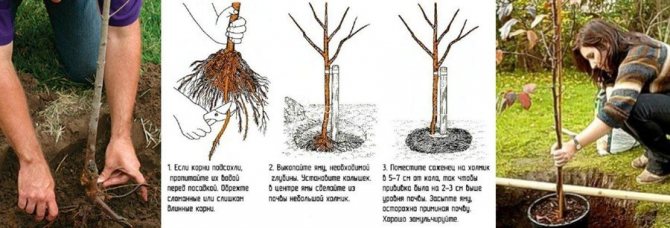

Figure 1. Correct planting of horticultural crops
It is important to make the hole the right size. The straightened roots should fit freely in it. After placing the seedling in the hole, the roots are sprinkled with fertile soil, watered and compacted. When the water is absorbed, you can water it again. In the future, it is necessary to observe the seedling in order to apply fertilizers in time, water or spray the crop from diseases and pests.
From the video you will learn how to properly graft fruit trees.
https://youtu.be/bOFLqxxP0TU
Seedling care
In order for the garden to be productive, and young plants to take root faster, they need to be constantly looked after.
Basic seedling care includes (picture 2):
- Caring for near-trunk circles includes a gradual expansion of the treated soil around the trunk. Since the root system is growing rapidly, the space is increased annually, surface loosening is carried out in the spring and deep digging with a pitchfork in the fall. In summer, weeds are removed from the tree trunks, which can interfere with the development of the seedling.
- Watering plays an important role in the rooting of seedlings. In temperate climates, it is enough to water 2-3 times a week, but if drought begins and natural precipitation is absent, moisture is applied daily (mainly in the evening).
- Fertilization especially important when planting on soils with low fertility. Nutrients entering the soil are absorbed by the roots, and the tree grows more actively and begins to bear fruit earlier.


Figure 2. The main stages of caring for fruit crops: pruning, whitewashing of trunks, watering and installing supports for branches
Young seedlings are also necessarily inspected for symptoms of diseases and pest larvae. This will allow spraying to be carried out on time to maintain the vitality of the crop. Also, pruning is carried out annually to form the crown and stimulate the formation of new shoots.
The features of caring for fruit trees are described in detail in the video.
https://youtu.be/IO-klBCR_VM
Pruning branches of apple trees by seasons:
In the spring
Young apple trees in spring need shaping and pruning. Shoots that thicken the crown are cut by 2/3, weak and dead by frost are cut out altogether, as well as broken ones. They also cut out competitors, tops and gains.
If they are more than 56 cm, then by half, if less, then by 1/3. In addition, crossed branches and shoots with traces of diseases are removed.
In the spring, this is done either before the leaves unfold or before flowering begins.
Watch the video of the formation of apple tree seedlings:
In autumn
Apple trees are pruned at the end of the fall... And such pruning of young apple trees consists in a slight shortening of new shoots that have stretched out over the summer. The trees are strongly pruned - cleaning, cutting the branches by a third of the length in case the trees have not been pruned at all before.
With a weak annual growth, cut off ½ shoots. If the growth is weak (less than 30 cm), then you should not remove large branches, this will further weaken the tree.
In the fall, remove all dry, too weak, broken shoots growing in the middle and shoots extending at an angle of 25 to 40 degrees from the trunk of the apple tree. Read more about pruning apple trees in autumn here.
IMPORTANT! A day with fogs and any kind of precipitation is not suitable for pruning apple trees!
Fruit trees for the garden: names and photos
Among the popular garden trees, there are many types. Unfortunately, not all of them are suitable for growing in temperate climates. For example, citrus and subtropical fruits can only be grown in warm southern regions.
The most common are these types of fruit trees and fruit shrubs. (picture 3):
- Pome fruits (pears, apple trees, quince, irga and mountain ash);
- Stone fruits (cherries, apricots, peaches, plums, etc.);
- Walnut (walnuts and hazelnuts, almonds);
- Berries (strawberries, wild strawberries, currants, gooseberries, raspberries, etc.).


Figure 3. Popular types of horticultural crops: 1 - pome fruit, 2 - stone fruit, 3 - walnut, 4 - berry
You can also grow wild rose, sea buckthorn, mulberry, honeysuckle and hawthorn in the gardens. The variety of species is very great, and thanks to the work of breeders, it was possible to develop varieties that are resistant to temperature extremes and diseases.
Varieties
One of the most important conditions for the successful cultivation of horticultural crops is the correct choice of the variety. All bred crops are tested for many years for compliance with the soil and climatic conditions of the region. Therefore, each climatic zone has its own varieties.
Winter-hardy varieties are considered the best, since they take root well in any climate, and a decrease in temperature does not affect productivity.
Among the best winter-hardy varieties, there are:
- Apple trees Antonovka, Grushovka Moscow and Medunitsa;
- Pears Lada, Chizhovskaya and Cathedral;
- Plums Amusing, Hungarian Moscow and Blue Gift.
There are also winter-hardy varieties of cherries (Molodezhnaya, Pamyat Yenakiyeva) and sweet cherries (Bryanskaya rozovaya, Tyutchevka, etc.).
Fertilizers for planting fruit trees
The acclimatization of seedlings also depends on the fertilizers that were applied during the planting process.
Note: When preparing the hole, the upper (fertile) layer of soil is removed and not mixed with the rest of the soil extracted from the hole. This land is later used to fill the space inside the hole.
Traditionally, organic and mineral fertilizers are used during planting. From organic fertilizers, you can use rotted manure and compost. Fresh organic matter cannot be used, since the release of ammonia during the decomposition process can provoke root rot.
From mineral fertilizers during planting, you can use any means, except for preparations containing nitrogen. Such feeding reduces the rate of plant survival. Nitrogen-containing preparations are added later, when the seedling is acclimatized.
Caring for fruit trees in early spring
Basic garden maintenance in spring involves pruning. First of all, shoots and branches damaged by frost are removed.
Preventive spraying is also carried out until the kidneys awaken. Most often, diesel fuel is used for this. It does not harm the seedling, covering it with an oily film, which blocks access to oxygen for the larvae.
Care rules
The basic rules of care include whitewashing and pruning (Figure 4). After inspecting the trunks and branches, remove all damaged parts. It is also necessary to remove the covers and inspect the trunks for damage. If there are wounds on the trunk or branches, they are cleaned of the remnants of the bark, treated with copper sulfate and covered with garden pitch.
Whitewashing of trunks has several functions. First, it destroys the larvae of pests that have overwintered under the bark. Secondly, it protects the bark from sunburn.


Figure 4. Rules for caring for the garden in spring
In addition, in the spring, complex mineral fertilizers are applied to the root circles, which will help the plants maintain yields and get the necessary nutrients from the soil.
Features of the
Among the features of spring gardening, preventive spraying against pests can be distinguished. They are carried out in several stages. The first time the treatment is carried out during the dormant period, when sap flow did not begin in the trunk and branches. The second time, processing is started during the flowering period, using special chemicals for this. All these activities help to protect crops from diseases and pest infestations.
A haircut
In order for ornamental trees and shrubs to always have a beautiful appearance, you need to regularly, throughout the growing season, cut and trim them.
If necessary, we carry out formative pruning of conifers and sanitary pruning of trees.
We cut hedges to increase the density of the branches and maintain the correct shape.
Cutting flowering shrubs must be done immediately after flowering, so that they have time to grow new greenery. As the flowering proceeds, we cut off the mock-orange, lilac, barberry, ornamental currant and other shrubs.
A feature of pruning in August is the removal of vertical shoots of trees growing in the upper part of the crown. With this technique, we regulate their growth. We also cut out diseased and shriveled branches. During this period, they are easiest to find among healthy people.
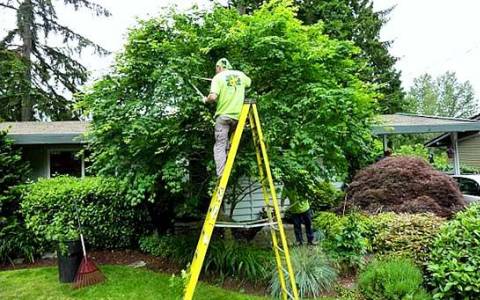

Caring for fruit trees in autumn
In the fall, they not only harvest, but also begin to prepare the garden for winter. It is not worth neglecting winter procedures, since their quality determines how successfully the crops will endure the cold season and retain the ability to bear fruit.
Care rules
In autumn, horticultural crops require such care (Figure 5):
- After harvest the trunks are completely cleaned of leaves, fruit residues and dry branches. Any organic matter on the soil surface will start to rot and can cause fungal infection.
- Under the root make potash and phosphorus fertilizers. This will help the plants gain strength before winter. It is not recommended to use nitrogen-containing fertilizers, as they activate growth and prevent plants from entering a dormant state.
- After stopping sap flow carry out pruning. But if the trees were not damaged, this point can be missed, since not all crops normally tolerate the removal of branches immediately before the onset of cold weather.


Figure 5. Autumn garden care and preparation of plants for winter
It is also advisable to re-whitewash the trunks with lime and spray the garden with insecticides.
Features of the
The main purpose of autumn care is to prepare trees for winter. Having collected the entire crop, be sure to clear the near-stem circles from leaves and dry branches, loosen the soil and apply potash and phosphorus fertilizers.
Autumn pruning is carried out only when necessary (for example, if sick or damaged branches were found), so as not to stress the plant before winter. Obligatory care also includes whitewashing of trunks and insulation of young crops. They are wrapped in insulating material, and the trunks are covered with mulch. This will help protect the plants from frostbite.
Also, rodent baits are laid out on the territory, which can damage the bark in winter.
Pests and weeds
Trees and shrubs in the summer can be attacked by all kinds of pests. Some insects harm plants in the course of their activity, while others are carriers of various infections. Therefore, preventive spraying should be directed against both pests and diseases and infections.
To do this, we use chemicals (fungicides, insecticides) or folk remedies. Here is one popular recipe for spraying: mix 50 g of soda ash (linen) soda and 40 g of laundry soap, dilute this mixture in 10 liters of water and spray every 8-10 days.
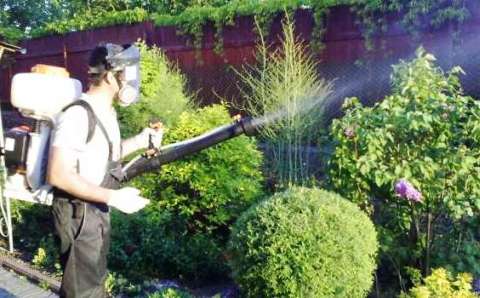

Weeds are another disaster for green spaces, they are also a kind of pests. On tree trunks, especially young trees, weeds should be destroyed because they create a favorable environment for the development of diseases, and in addition, attract harmful insects.
Herbicides can be used to control weeds, but it is better to destroy them by loosening the soil and picking them up by hand. Mulching of tree trunks can be a prophylaxis for the appearance of weeds.
Pruning fruit trees in spring: scheme
Pruning in the right way in the spring will help speed up crop growth, maintain yields, and help prevent disease.
Note: Pruning can be carried out in winter, but only in the absence of severe frosts. If the temperature drops below -8 degrees, branches cannot be removed, since the resulting wound can lead to the death of the entire plant.
There are several types of pruning that can be done in the spring. (Figure 6):
- Sanitary involves the removal of all damaged and diseased branches. It is this procedure that is carried out in early spring, during the inspection of crops after winter.
- Rejuvenating helps to maintain the yield of old specimens. In this case, old branches are removed, which practically do not bear fruit. In their place, new shoots with young fruitful shoots are formed.
- Pruning for crown formation more suitable for young seedlings, branches on which grow chaotically. The main goal of the procedure is to form a crown of the correct shape and free the central part of the trunk from unnecessary branches to activate fruiting.
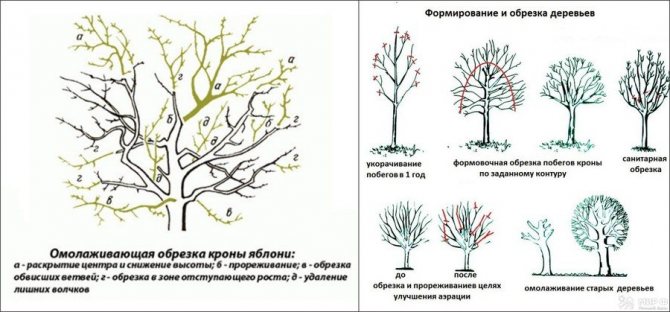

Figure 6. Types of spring pruning
For pruning, only sharp garden tools are used: pruners and special hacksaws, with which you can make an accurate and even cut.
When to start pruning
Regardless of the climatic zone, when to start pruning in the spring depends on temperature and weather conditions.
Note: The general rule of thumb is to delete branches when the tree is dormant. So it will experience less stress, and the wound will heal faster.
As a rule, spring pruning begins in March. At this time, the movement of the juice has not yet begun, but the buds are already ready to awaken, so the wounds will heal quickly, and the plant will not experience severe stress.
Pruning rules
The main rule of spring pruning is to determine in time the moment when the tree is still sleeping, but the buds are ready to open. So you will fulfill several important conditions at once: remove excess or damaged branches without stressing the culture, and speed up wound healing.
Among the basic rules are the following:
- For work, only sharp garden tools (sectors and hacksaws) are used so that the cut is smooth. The hacksaw you use for cutting should not be used for construction or other work.
- It is advisable to prune in warm, calm weather, so that the cut is not damaged by cold air and wind.
- After the procedure, the cut site is covered with garden pitch, and the trunk is whitewashed with lime.
By observing these simple rules, you can easily maintain the vitality of trees, renew old plants and activate the growth of young ones.
Removing unnecessary growth
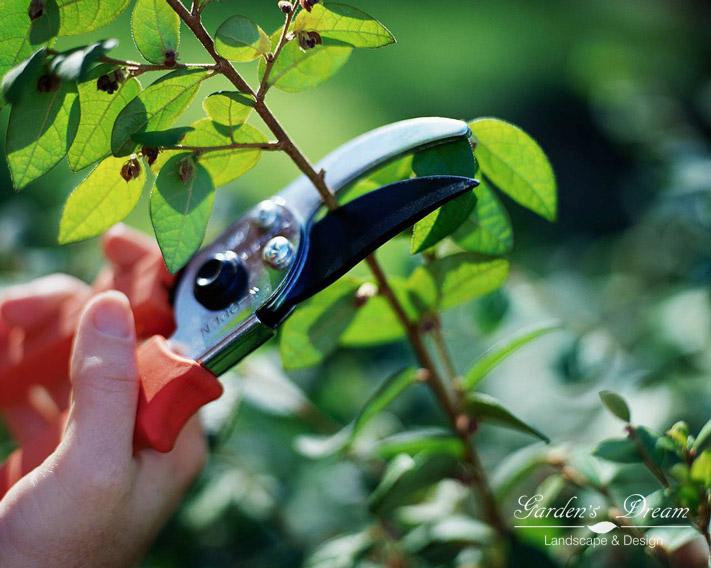

Fruit trees and shrubs often scatter shoots that reduce the attractiveness of the garden, slow down growth, the development of garden plantings, and disrupt the harmony of landscape design. In the process of updating the garden, it becomes necessary to remove mature trees, uproot stumps.
Our specialists carefully and safely carry out all the work to remove unnecessary plants. The cost of work depends on the type, size of tree-like plants.
| № | Name of works | Unit rev. | Price |
| 1 | Shrub removal | PC. | from 50 p. |
| 2 | Removing trees | PC. | from 150 p. |
| 3 | Grubbing tree stumps | PC. | from 500 p. |
| 4 | Removal of vegetable turf (lawn) | sq.m. | from 50 p. |
Notes: 1) The cost of removal depends on the size of the removed plant. The removal of plant residues is paid separately. 2) When removing the vegetable turf (lawn), transportation over a distance of 50 m is paid additionally.
Pruning fruit trees in winter
Contrary to popular belief, in winter, trees are not only possible but also necessary to be pruned. The only contraindication is severe frost. If the air temperature drops below -8 degrees, the branches should never be removed.The resulting wound will take a very long time to heal, and the plant may die.
However, winter pruning has several important benefits. First, the tree is dormant and not under severe stress. Secondly, branches devoid of leaves are much easier to handle and inspect, so the cut can be made more accurate and even.
The place of the cut must be covered with garden varnish to protect healthy tissues from hypothermia or damage.
Pruning fruit trees in winter: video for beginners
Since winter pruning has some peculiarities, certain rules must be followed to carry it out.
If you have never removed branches in winter before, we recommend watching a video that will help you carry out the procedure correctly, while maintaining the productivity and vitality of the crop.
https://youtu.be/z3nQW2Lx98c
Grafting and grafting of fruit trees
Grafting and re-grafting is one of the main stages of caring for horticultural crops (Figure 7). Grafting is a method of vegetative propagation of fruit crops. A seedling grown from seeds, in most cases, does not retain varietal characteristics, therefore it is grafted (a bud or a cutting is transferred from another crop). After fusion, the gardener gets a full-fledged varietal tree.


Figure 7. Features of vaccination and re-vaccination
Re-vaccination has a lot in common with vaccination, with the exception of one significant difference. A stalk with formed buds from another variety or even a plant is implanted into the trunk. As a result, the main tree will develop and bear fruit separately, and a full-fledged shoot will grow at the grafting site, which will bear the fruits of its own variety.
Note: With the help of grafting, you can successfully grow crops that, due to climatic or soil conditions, cannot be cultivated traditionally.
A good example of grafting is the transfer of a quince bud to an apple tree trunk or branch. The branch formed from the cutting will begin to develop actively, and it will be possible to harvest two completely different crops.

